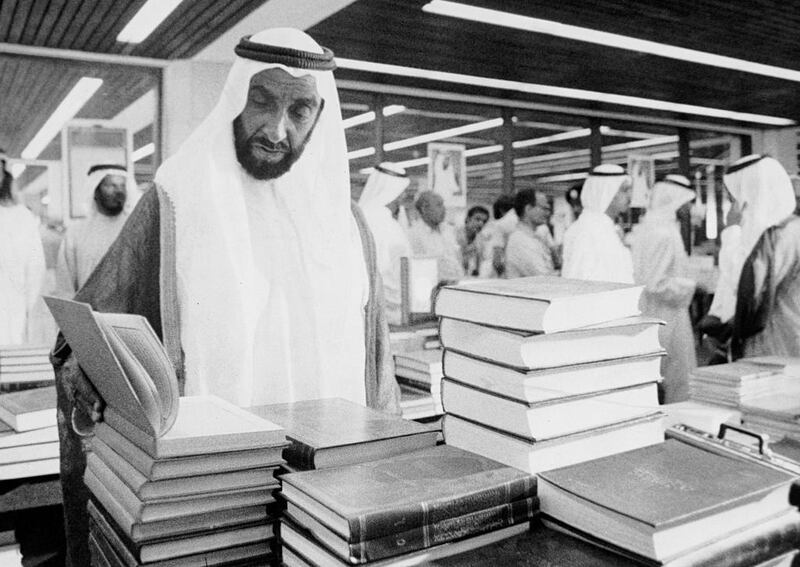Today, a little over half a century ago, an event occurred which marked, in many ways, the birth of the modern United Arab Emirates.
For relatively recent arrivals in the country who might not know as well as any other resident of a tender age, whether citizens or foreigners, that event was the accession of the late Sheikh Zayed to the position of Ruler of Abu Dhabi on August 6, 1966.
It was an occasion that was formally and joyously marked every year until he died, providing an annual opportunity to reflect upon his achievements, first as ruler and then, from 1971, as president and founding father of the UAE. It provided, too, a chance to look forward to what lay ahead for further progress was always on the horizon.
A sketchy outline of Sheikh Zayed's life up to his accession is perhaps known to most people because of the media coverage this year on the 100th anniversary of his birth.
Born in 1918, he became the representative in Al Ain in 1946 for his brother Sheikh Shakhbut, who was then the Abu Dhabi ruler.
He served there for 20 years, laying the foundations for its development, from trade to agriculture and municipal services and successfully navigating the choppy political waters relating to the ownership of the nearby villages of Buraimi and Hamasa.
During those two decades in Al Ain, he gained experience of governance and consolidated his relationships with local tribes, both in the Al Ain area and throughout the adjacent deserts. He also developed the vision for the country’s future development that he would later implement.
In the early 1960s, Abu Dhabi had become an oil producer, first offshore in 1962 and then onshore in 1963 and it became apparent that a new leader was required to take the emirate forward.
And so it was that in 1966, a consensus emerged within the ruling Al Nahyan family that Sheikh Zayed should succeed his brother as ruler.
With his vision for the future already prepared, within a few weeks of his accession he set in motion a whole raft of major initiatives, including the creation for the first time of a formal structure of government departments.
The pace of change was dramatic and one historian has described Sheikh Zayed’s leadership at this time as being characteristic of "a man in a hurry".
Over the next decade, there were many challenges to face. At home, a comprehensive programme of social and economic development was initiated including, importantly, the introduction of a proper system of education.
The announcement by Britain that it would be withdrawing from the Arabian Gulf by the end of 1971 prompted the launch of intensive discussions on the formation of the UAE.
Externally, the seizure by Iran in late 1971 of the three islands of Abu Musa and Greater and Lesser Tunb complicated the emergence of the newly formed UAE on the international stage.
The Arab-Israeli War of October 1973 brought further challenges, even if the related increase in oil prices meant that sufficient revenues were available to fund the burgeoning development programme.
Looking back with the benefit of hindsight, it’s easy to identify the key achievements made by Sheikh Zayed in the first years after his accession as ruler and then president.
It is more difficult, however, to assess some of the challenges that he faced and overcame. They have faded away and in many cases, it is difficult even to comprehend the circumstances in which they arose.
The unity of the UAE federation is now part of life; it is difficult even to imagine an alternative. Yet half a century ago, long, patient and sometimes frustrating negotiations between the seven emirates were required to secure agreement on its establishment. Most external observers gave it little chance of success.
The process of modern development had only just begun when Sheikh Zayed became ruler. Health services were minimal, diseases like malaria common, infant mortality rates were high and public housing was virtually non-existent.
Today there are tens of thousands of Emirati university graduates, men and women who are able to contribute to the country’s development in both the private and the public sector.
When Sheikh Zayed became Ruler of Abu Dhabi, there were less than half a dozen university graduates in the emirate, none of whom were women.
There were no cohorts of educated officials upon whom Sheikh Zayed could depend to realise his ambitions. At the beginning, the task fell to a very small group of people who shared both his vision and his determination and set to work, with limited resources, to build a nation almost from scratch.
Half a century on, it is good to reflect on that process, which began with Sheikh Zayed’s accession.
Of course, some of the foundations of the UAE were laid much earlier but August 6, 1966, is when the country of today was born.
It is a date that those of us who remember the years of Sheikh Zayed as ruler, president and founding father, continue to cherish.
Peter Hellyer is a consultant specialising in the UAE's history and culture





